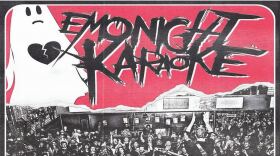In 2011, MIT named Sam Asano one of the most influential inventors of the 20th Century. His first invention, the portable fax machine, went on to become the worldwide standard. But there are some problems even inventors can’t solve.
Asano sits in his Portsmouth office thinking about shoes. After the 83 year old fell not long ago he invented special insoles that could both detect a fall – and then automatically summon help. “Basically,” he says, “by doing this, I have become a sort of a specialist on walking.”

As field testing began for the fall detecting insoles, Asano began to wonder - could he make shoes that never slip? He turned to nature. He turned to wolves. “They can't afford to slip and so their foot, it's very well designed,” Asano says. “In all kinds of conditions water, water over the ice, and you know water gets sucked up by the fur. So that's my next project of copying you know, wolf's feet.”
Welcome to the mind of an inventor – or, as Sam Asano prefers to think of it, “problem solver”. To tell me the story of how he became a problem solver, Asano takes me back 73 years. “During World War Two my family lived in a mountainous village,” he recalls, “because that's the safest and there was a top secret airport there in the mountains and the Japanese Air Force was experimenting with various planes.”
Sometimes the experimental Japanese Zeroes crashed. Asano would find the wreckage and sit inside the cockpit.
But one day, the boy stumbled across the remains of an American B-29. “The Japanese Zero plane, inside, even the broken ones are meticulously built. Beautiful. I was 10 years old but I could see the workmanship,” Asano says. “B-29 meanwhile was a huge aircraft and the inside was a mess. It was really slapped together and I was sort of amazed at how could this kind of thing fly?”
It seemed impossible to the 10 year old that a country that made such a bad airplane could ever defeat a country that made the beautiful Zero.
Why Japan lost the war became Sam Asano’s first big problem. “When a nation loses a war they go through a huge amount of psychological recrimination,” he says. “They go through this you know terrible feeling that how come we are so bad?”
The question haunted Asano until the age of 15 when he read that one of the early deciding factors in the war was the United States use of radar. And when he learned that a Japanese scientist had developed radar technology in the 1920’s, “All of a sudden” he says, “my sort of feeling that we were totally hopelessly inferior disappeared. So we're not inferior but we don't manage well. We didn't choose the right path. I decided to come to the United States then because I wanted to know if we were equally smart then why one country pushed ahead to make a product and the other countries don't.”
He received a Fulbright scholarship to MIT where the last piece of the puzzle fell into place. “You know Japan which is very organized almost like a crystal clean culture,” he says. “And here in this country is sort of turbulent. In Japan everything is no, unless it's absolutely yes.”
In this country, he discovered, everything was yes - often when it was absolutely no. “I learnt a lot by that sort of infinitely optimistic approach,” the inventor says.
After graduating from MIT, Sam Asano took a job working on a project for NASA that would later become the Hubble Telescope. But it was while designing an x-ray sensitive camera for the nose cone of the rocket that Asano encountered his next problem – and his first invention.
Before any test launch, two engineers would ascend the scaffolding towers to make last minute adjustments to Asano’s camera. “I have to call them to adjust screws and so forth,” he says. “Now the reason I come up with the idea of the fax machine is that I never understood very well what they say and I said to myself, you know, can't we just write something on a piece of paper and show it?”
Fax machines existed at the time. But they were expensive, massive, and prone to breaking. Over the course of the next year, Asano built his own version. Small, portable, and simple. Reinvention would become a pattern for Asano - along with a belief that inventors should look to their own lives to find problems to solve. “Personal problem is the best,” he says, “because you can live with the problem. So you can always observe it.”

As he's gotten older, and settled into his life in America, he's noticing ways this country is changing - the decline of manufacturing - the disappearance of people who make things. “I remember when I landed in Cambridge in 1959. Cambridge was a factory city,” Asano says. “And there was MIT and Harvard and in between was packed with little guys who were running machineries. You know, and all of that is forgotten.”
For Asano, this means the spirit of invention itself has died. “There's a children's song in Japan called "What Shall We Do with the Canary that Lost his Song?” Asano tells me. “ In other words - our song was industry and we lost it. We don't know how to sing anymore.”
But Sam Asano is not without hope. He is still singing, he says. And he’d be happy to teach you the song.







